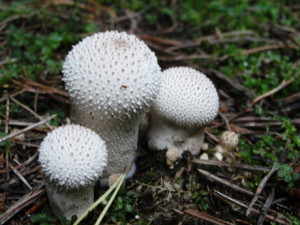
Puffballs are about the size of golf balls in Florida
Puffballs were the sight to see last Sunday at our foraging class in Melbourne. Those and watercress and a fruiting pawpaw. It was a windy day but no rain. Puffballs are controversial, with some mushroom hunters viewing them as prime edibles and others avoiding them completely. Puffballs should alway be cut open, top to bottom, to assure the inside is all one texture (like cream cheese) and does not have an outline of a mushroom inside. The watercress, a tasty ditch-loveing annual, was in blossom, a sign cold weather is leaving us.
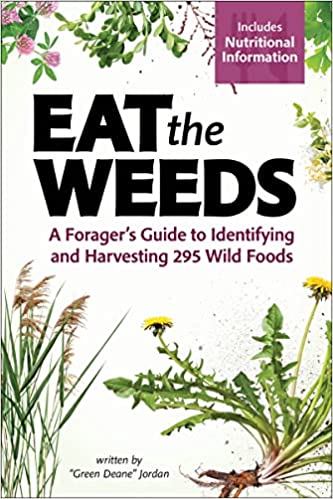 The Book, Eat The Weeds, is now on pre-order at Amazon. It will be published in mid-October. This is volume one. In hindsight, it was a 18-year project. Most of the material was written for my website starting in 2005, ythe nutritional elements – mostly for the book — were added in recent years. Following that was three years of negotiating, editing, and various tweaking along with a major residential move, an epidemic and a stroke. The basic difference between the book and my website is the explanation of botanical names was mostly removed and nutritional information about the plants added. The website has some 700 plants while this book has about 300 with color photos. The book covers North America and is not just about Florida plants.
The Book, Eat The Weeds, is now on pre-order at Amazon. It will be published in mid-October. This is volume one. In hindsight, it was a 18-year project. Most of the material was written for my website starting in 2005, ythe nutritional elements – mostly for the book — were added in recent years. Following that was three years of negotiating, editing, and various tweaking along with a major residential move, an epidemic and a stroke. The basic difference between the book and my website is the explanation of botanical names was mostly removed and nutritional information about the plants added. The website has some 700 plants while this book has about 300 with color photos. The book covers North America and is not just about Florida plants.
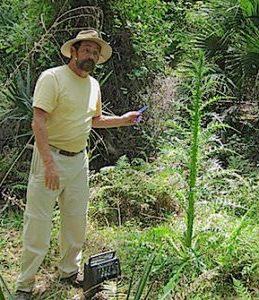
Foraging classes are held rain, shine, hot or cold. Photo by Nermina Krenata
Rain might be on tap during our foraging classes this week in Sarasota and Gainesville. We forage in the rain because one can be hungry when it rains.
May 06, Red Bug Slough 5200 S. Beneva Road, Sarasota. 9 a.m.,
May 07 Blanchard Park, 2451 Dean Rd, Union Park, FL 32817 9 a.m. Meet at the pavilion beside the tennis courts.
May 13, Boulware Springs Park, 3420 SE 15th St., Gainesville, FL 32641. 9 a.m. Meet at the picnic tables next to the pump house.
May 14, Mead Garden: 1500 S. Denning Dr., Winter Park, FL., 9 a.m. meet at the bathrooms.
May 20th, Bayshore Live Oak Park, Bayshore Drive. Port Charlotte., 9 a.m., meet at the parking lot at Bayshore and Ganyard Street.
May 21st, Dreher Park, 1200 Southern Blvd., West Palm Beach, 9 a.m., meet just north of the science center.
Bring cash on the day of class or click here to pay for your class
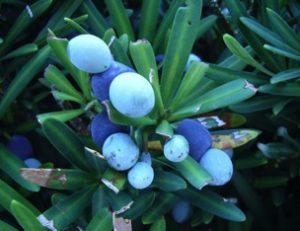
podocarpus arils and seeds maturing. Photo by Green Deane
It’s a long ways to August but the Podocarpus is making seeds and that means edible arils in a few months. The species is a bit strange in that we don’t eat the mildly-toxic seed. We eat the aril next to it which are very grape-like. They can be used as grapes, eaten off the bush or made into jelly and wine et cetera. The seeds are listed as toxic but I know of an adult who ate two at one time and had no issue. That said, don’t eat the seeds. When the Podocarpus fruits can be something of a guess. Locally I look for them in August. The fruit can last several weeks and are edible even when they begin to dry and look like raisins. Oddly, in a local park in downtown Winter Park, a few Podocarpus have escaped trimming and have grown into moderate-size trees. Those fruit in December and my only guess as to why is perhaps they are a different species. My video on Podocarpus is here and you can read about it here.
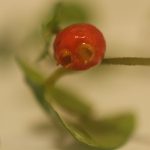
Partridgeberry has two dimples where twin blossoms were. Photo by Green Deane
It is the season time for partridgeberries. While they can be found locally they are more a cooler climate species. I used to find them occasionally in Gainesville Fl but saw them often in western North Carolina. Botanically Michlla repens, the species has been used for food and as a diuretic and for the pain associalted with menstrual cramps and child birth. M. repens is a vine that does not climb. It does make an excellent ground cover. The berry is favored by the ruffed grouse hence the name Partridgeberry.
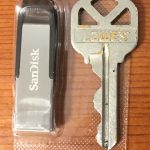
You get the USB, not the key.
My nine-DVD set of 135 videos has been phased out and replaced by 171-videos on a 128-GB USB, see right. The USB videos are the same videos I have on You Tube. Some people like to have their own copy especially if social order falters. The USB videos have to be copied to your computer to play. If you want to order the USB go to the DVD/USB order button on the top right of this page or click here. That will take you to an order form. Or you can make a $99 donation, which tells me it is for the USB (include a snail-mail address.) I’d like to thank all of you who ordered the DVD set over the years which required me to burn over 5,000 DVDs individually. I had to stop making them as few programs now will read the ISO files to copy them. Burning a set also took about three hours.

Green Deane Forum
Want to identify a plant? Perhaps you’re looking for a foraging reference? You might have a UFO, an Unidentified Flowering Object, you want identified. On the Green Deane Forum we — including Green Deane and others from around the world — chat about foraging all year. And it’s not just about warm-weather plants or just North American flora. Many nations share common weeds so there’s a lot to talk about. There’s also more than weeds. The reference section has information for foraging around the world. There are also articles on food preservation, and forgotten skills from making bows to fermenting food. Recent topics include: Stale Bread and Cod Liver Oil, Killing Bugs with Tobacco Plugs, Eating weeds: Is it safe? Have they mutated? Not the Eastern Red Bug but the Pink Tabebuia, African Tulip Tree, Asparagus densiflorus, Green Deane’s Book… You can join the forum by clicking on the button on the upper right hand side of this page.
This is my weekly newsletter #556. If you want to subscribe to this free newsletter you can find the sign-up form in the menu at the top of the page. My website, EatTheWeeds.com, which is data secure, has over 1500 plants on it in some 428 articles. I wrote every one myself, no cut and paste.
To donate to the Green Deane Newsletter click here.

